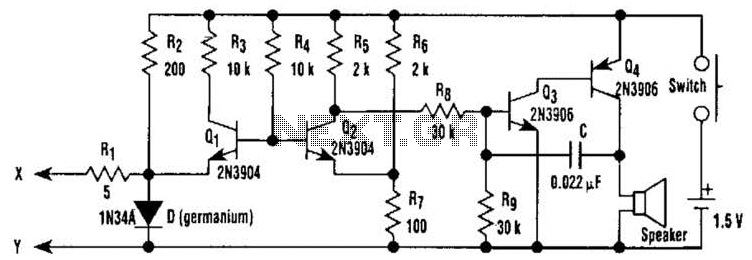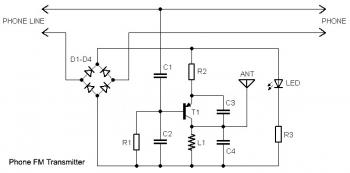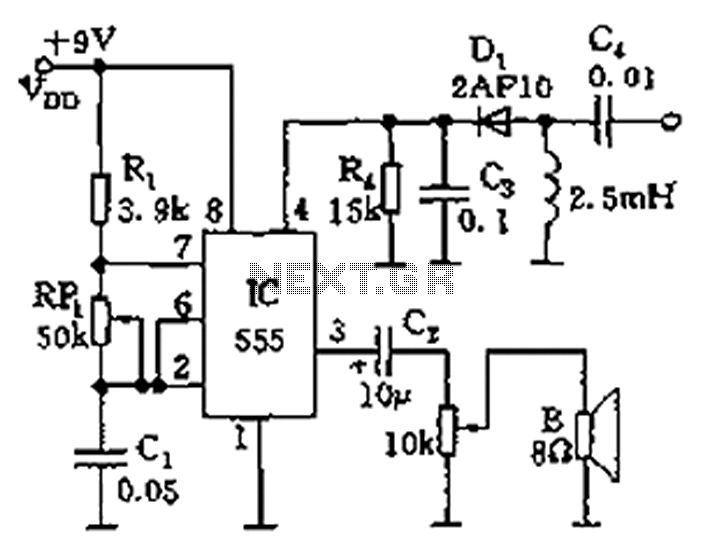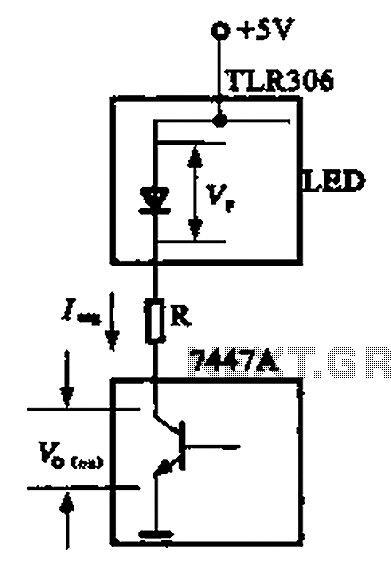
Room Ioniser circuit

This is a voltage multiplier circuit functioning as an ionizer. It is designed to convert 220V from the mains supply into an output of approximately 6kV. Caution is advised when handling this circuit due to the potential dangers associated with high voltage from the mains. A needle can be positioned at the output, measuring 3 cm in length. Additionally, even after disconnection from the mains, the capacitors can remain hazardous; therefore, it is essential to discharge them by shorting their terminals before any physical contact with the circuit.
The voltage multiplier circuit operates by utilizing a series of capacitors and diodes to step up the input voltage to a much higher level. Typically, a Cockcroft-Walton (CW) configuration is employed, which consists of multiple stages of capacitors and diodes. Each stage increases the voltage by a factor that depends on the number of stages and the input voltage.
In this specific design, the circuit begins with a step-up transformer that increases the 220V AC mains voltage to a higher AC voltage suitable for the multiplier stages. The output of the transformer is then rectified using diodes, which convert the AC voltage into pulsating DC voltage. The capacitors in the multiplier circuit store charge and release it in a manner that effectively multiplies the voltage with each stage.
Safety precautions are paramount due to the high voltage output of approximately 6kV, which can pose serious risks. The circuit should be housed in an insulated enclosure to prevent accidental contact with live parts. Furthermore, the use of a long needle at the output serves to enhance the ionization effect by providing a sharp point that facilitates the discharge of ions into the surrounding air.
When working on or around this circuit, it is crucial to ensure that all capacitors are properly discharged before handling. This can be accomplished by using insulated tools to short the capacitor terminals, thereby preventing any residual charge from causing electric shock. Proper personal protective equipment (PPE) should also be worn to further mitigate risks associated with high voltage circuits.
Overall, this voltage multiplier circuit serves a specialized function in ionization applications, but it requires a thorough understanding of high voltage safety practices to operate and maintain effectively.This is a voltage multiplier circuit acting as an Ioniser. Its calculated to feed 220V from mains and the output is about 6KV. Caution should take with the circuit as can be dangerous due to mains. You can place a needle at the output 3cm long. Even you disconnect from mains, capacitors can be dangerous so make sure to discharge them by shorting their pins before you touch the circuit with hands.
The voltage multiplier circuit operates by utilizing a series of capacitors and diodes to step up the input voltage to a much higher level. Typically, a Cockcroft-Walton (CW) configuration is employed, which consists of multiple stages of capacitors and diodes. Each stage increases the voltage by a factor that depends on the number of stages and the input voltage.
In this specific design, the circuit begins with a step-up transformer that increases the 220V AC mains voltage to a higher AC voltage suitable for the multiplier stages. The output of the transformer is then rectified using diodes, which convert the AC voltage into pulsating DC voltage. The capacitors in the multiplier circuit store charge and release it in a manner that effectively multiplies the voltage with each stage.
Safety precautions are paramount due to the high voltage output of approximately 6kV, which can pose serious risks. The circuit should be housed in an insulated enclosure to prevent accidental contact with live parts. Furthermore, the use of a long needle at the output serves to enhance the ionization effect by providing a sharp point that facilitates the discharge of ions into the surrounding air.
When working on or around this circuit, it is crucial to ensure that all capacitors are properly discharged before handling. This can be accomplished by using insulated tools to short the capacitor terminals, thereby preventing any residual charge from causing electric shock. Proper personal protective equipment (PPE) should also be worn to further mitigate risks associated with high voltage circuits.
Overall, this voltage multiplier circuit serves a specialized function in ionization applications, but it requires a thorough understanding of high voltage safety practices to operate and maintain effectively.This is a voltage multiplier circuit acting as an Ioniser. Its calculated to feed 220V from mains and the output is about 6KV. Caution should take with the circuit as can be dangerous due to mains. You can place a needle at the output 3cm long. Even you disconnect from mains, capacitors can be dangerous so make sure to discharge them by shorting their pins before you touch the circuit with hands.




